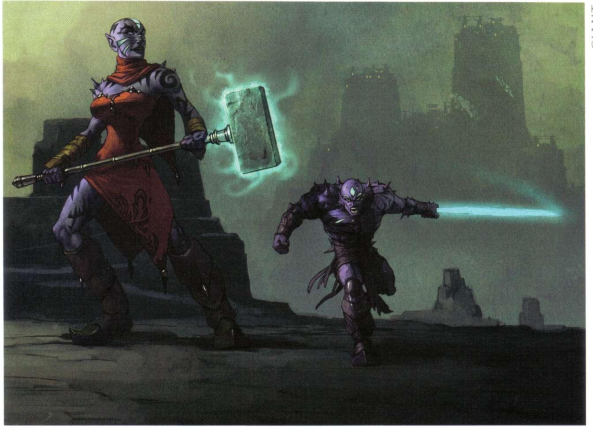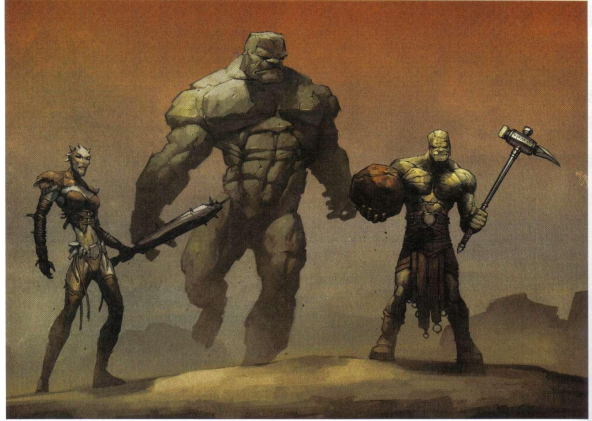Let's Read the 4e Monster Manual 2: Giants
The first Monster Manual and the Monster Vault contained plenty of giants, whose lore in 4e is pretty awesome. I covered their basic lore here, and also had individual posts for hill, frost, fire, death and storm giants.
The Monster Manual 2 added more giants, and it’s actually where Frost Giants made their first appearance in this edition. We already covered them in the corresponding post linked above. In this one, we’ll cover the two other varieties introduced in the same entry: Eldritch and Stone giants. The latter are old standbys, and I had never heard of the former until now. If they existed in a previous edition, it was in one of the more out-of-the-way supplements or Dragon articles for 3e.
Eldritch Giants

As mentioned in the basic lore post, the primordials made the first Giants from the same elements they used in the world, to help them shape and understand it. Well, it turns out raw magic is as much a basic building block of the world as the more classical elements of earth, fire, air, and water. Therefore, it got its own Giant type.
Eldritch giants were among the most powerful creations of the Primordials, and they helped a lot with shaping the flow of magical energies in the still-cooling world. Today their power is much diminished from what it was at the dawn of time, and most of them dedicate their lives to accumulating magical power and knowledge in hopes of returning to those lofty heights.
Both eldritch giants and titans are still well-versed in magic. They know how to form weapons out of pure force, and they tattoo their bodies with symbols that allow them to absorb the magic of others and teleport at will. They live near sources of arcane power, and jealously hoard knowledge and artifacts. Eldritch giant social hierarchy is based on how much power individuals managed to accumulate - Eldritch Titans tend to be at the top. An individual eldritch giant or titan might have more abilities than what is depicted in the “typical” stat blocks of this entry, and they’ll certainly have access to lots and lots of magic rituals.
Most interactions between mortals and eldritch giants as written here are likely to be hostile, since the giants don’t have much reason to be friendly. They love binding and enslaving other creatures with magic, though, so they might be encountered alongside powerful elementals, slaads, and other such creatures. A more reasonable group of them would make valuable allies against powerful incorporeal enemies, though, since they specialize in force magic.
Eldritch Giant
“Standard” eldritch giants are Large Fey Humanoids with the “giant” keyword, and Level 18 Skirmishers with 171 HP. They have low-light vision, 10 force resistance, and a +5 bonus to saves vs. charm effects. Their ground speed is 8 and they also have a teleport speed of 6.
These giants fight in melee with Reach 2 Eldritch Blades that target Reflex and deal force damage, and at range with Range 20 Force Missiles that do the same. Being so large, they can also use Sweeping Sword attacks to target everyone in a Close Blast 2 instead of a single victim, and they can do that even when charging.
As a minor action, they can deploy an Eldritch Field (close blast 5; recharge 5+) that counts as difficult terrain and makes enemies inside take extra damage from the their attacks. Also as a minor action, they can use Consume Magic to absorb a magic zone created by a PC. This requires them to hit the caster’s Will with an attack, and if they succeed their own attacks get a big damage boost until the end of their next turn.
Eldritch Titan
Eldritch Titans are Huge, and Level 21 Elite Skirmishers with 394 HP. They have the same passive traits as their smaller cousins.
Their Reach 3 Eldritch Hammers deal more damage, and they can make two attacks per action, even on a charge. Their ranged force attack is also stronger and pushes the target 5 squares on a hit.
Once per encounter they can cast a Force Hammer that damages everyone on a close blast 3, pushes then 3 squares and knocks them prone. On a miss the targets still take half damage and are pushed. They have the same Consume Magic and Eldritch Field abilities as eldritch giants.
Stone Giants
The other type of classic earth giant, Stone Giants are among the most reasonable people among all giantkind. They usually don’t care about raiding or conquest, and just want to be left alone in their mountain homes. Discrete and contemplative sorts, they can stay immobile for years while lost in thought, and are surprisingly adept at hiding themselves in their home terrain.
Someone passing throug stone giant territory might never spot them at all, and ill-intentioned travelers might find themselves ambushed before they can do any harm. The exception to all of this is when the giants are feeling rowdy and want to have some fun: their favorite game is basically dodgeball with enormous boulders, and when they’re in the middle of it they don’t usually pay attention to any smaller creatures who might be in the path of those boulders.
Stone giants are one of the few Giants who are actually on friendly terms with communities of galeb duhrs and azers. They have a long and proud tradition of stone carving, and their magic is based on carved runes. It’s possible the dwarves originally learned their own rune-magic from stone giants, though modern dwarf scholars dispute this notion.
Friendly giants of other types, unable to stand their generally unpleasant societies, often move in with stone giants. Conversely, evil stone giants tend to move out of their ancestral homes and throw their lot with their more villainous relatives.
Stone Giant

Stone Giants are Large Elemental Humanoids with the Earth and Giant keywords. They’re Level 14 Soldiers with 140 HP, immune to petrification, and have a ground speed of 8 with Earth Walk. This lets them ignore difficult terrain with a “geological” origin.
They use giant-sized stone greatclubs. As usual for soldiers, their basic attacks mark on a hit and they can make opportunity attacks marked creatures in reach that move or shift. They can also make a Staggering Sweep that works like an area attack, pushes targets 2 squares, and marks them. At range, they can hurl rocks like you’d expect out of an old-school giant.
While they’re unbloodied, they can use Stone Bones as an interrupt when hit by an attack, gaining 5 resistance do its damage.
Stone Giant Runecarver
This spellcaster is a Level 16 Controller with 155 HP and the Leader keyword. Their magic is partly about slowing and immobilizing enemies, and partly about doing unpleasant things to enemies suffering from those conditions.
They fight in melee with Enruned Picks, which are High-Crit weapons and have a slow (save ends) rider. Grasping Stone ensures that any enemy slowed by the giant is also immobilized for a turn.
Magic-wise, their Rune of Thundering Echo (recharge 5+) deals thunder damage over an area and inflicts ongoing thunder damage (save ends) on targets who are slowed or immobilized. The Rune of Stony Sleep (recharge 6+) affects a similar area, deals physical damage and slows (save ends). After the first failed save, slowed enemies become petrified instead (save still ends). That rune also creates a zone within its affected area that inflicts a -2 penalty against saves vs. slowness or immobilization effects.
“Save ends” petrification might not sound so bad, but runecarvers also have a Hardened Focus aura (5) that makes all petrified enemies inside lose any damage resistance they have and gain Vulnerable 5 to all damage. An evil runecarver is a good counter to a group of PCs who thought a fight against frost or fire giants was going to be easy just because they packed the right elemental resistances.
Stone Titan
Stone Titans are basically Stone Giants Plus, being Huge in size and Level 18 Elite Soldiers with 348 HP. They fight unarmed and throw rocks, but there are some important differences.
First, their marking ability is a Slipstone Distortion aura (1) that marks any enemy who starts their turn inside. Their slams deal extra damage to marked enemies, and they can make opportunity attacks against marked enemies like stone giants can.
Second, they can use an Avalanche Stomp (encounter) to attack everyone in a Close Burst 3, with a hit doing heavy damage and causing the very earth to grab the targets. The escape DC is 28, and the giant doesn’t need to spend actions to sustain the grab. A miss still does half damage.
And third, they can “charge” a thrown rock and turn it into a Quakestone (recharge 5+), making it into an area attack that does light damage, knocks prone, and dazes (save ends) on a hit. A miss does half damage and knocks prone without the daze.
Final Impressions
Eldritch giants have a somewhat unusual name and appearance when compared to the traditional types, but they’re a lot closer to them than it seems at first. I guess calling them “Force Giants” would have been a little too on the nose, but this is basically what they are. They use Force attacks in the same way a frost giant would use Cold, or a fire giant would use Fire. Their fighting style is similar, aside from the “I eat magic!” thing.
Stone giants on the other hand are one of the traditional types that have been there since the beginning. I’m happy to see them here because your average stone giant fits the “Earth Giant” mold a lot more readily than a hill giant, who’s just a big human-looking person. I also like that the book doesn’t consider all of them evil, and even mentioned that they partner up with non-evil individuals of the other giant types. I often ponder how to make sapient monsters less evil and hostile when I discuss them, so it’s nice to see an entry that does that as written.